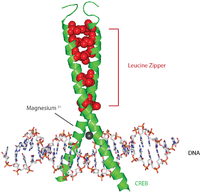
CREB-TF (CREB, cAMP response element-binding protein)[1] is a cellular transcription factor. It binds to certain DNA sequences called cAMP response elements (CRE), thereby increasing or decreasing the transcription of the genes.[2] CREB was first described in 1987 as a cAMP-responsive transcription factor regulating the somatostatin gene.[3]
Genes whose transcription is regulated by CREB include: c-fos, BDNF, tyrosine hydroxylase, numerous neuropeptides (such as somatostatin, enkephalin, VGF, corticotropin-releasing hormone),[2] and genes involved in the mammalian circadian clock (PER1, PER2).[4]
CREB is closely related in structure and function to CREM (cAMP response element modulator) and ATF-1 (activating transcription factor-1) proteins. CREB proteins are expressed in many animals, including humans.
CREB has a well-documented role in neuronal plasticity and long-term memory formation in the brain and has been shown to be integral in the formation of spatial memory.[5] CREB downregulation is implicated in the pathology of Alzheimer's disease and increasing the expression of CREB is being considered as a possible therapeutic target for Alzheimer's disease.[6] CREB also has a role in photoentrainment in mammals.
- ^ Bourtchuladze; et al. (1994). "Deficient long-term memory in mice with a targeted mutation of the cAMP-responsive element-binding protein". Cell. 79 (1): 59–68. doi:10.1016/0092-8674(94)90400-6. PMID 7923378. S2CID 17250247.
- ^ a b Purves, Dale; George J. Augustine; David Fitzpatrick; William C. Hall; Anthony-Samuel LaMantia; James O. McNamara & Leonard E. White (2008). Neuroscience (4th ed.). Sinauer Associates. pp. 170–6. ISBN 978-0-87893-697-7.
- ^ Montminy, MR; Bilezikjian, LM (1987). "Binding of a nuclear protein to the cyclic-AMP response element of the somatostatin gene". Nature. 328 (6126): 175–178. Bibcode:1987Natur.328..175M. doi:10.1038/328175a0. PMID 2885756. S2CID 4345292.
- ^ Dibner, Charna; Schibler, Ueli; Albrecht, Urs (2010). "The Mammalian Circadian Timing System: Organization and Coordination of Central and Peripheral Clocks" (PDF). Annual Review of Physiology. 72 (1): 517–549. doi:10.1146/annurev-physiol-021909-135821. PMID 20148687.
- ^ Silva; et al. (1998). "CREB and Memory" (PDF). Annual Review of Neuroscience. 21: 127–148. doi:10.1146/annurev.neuro.21.1.127. PMID 9530494. Archived from the original (PDF) on 28 August 2008. Retrieved 22 January 2010.
- ^ Downregulation of CREB expression in Alzheimer's brain and in Ab-treated rat hippocampal neurons